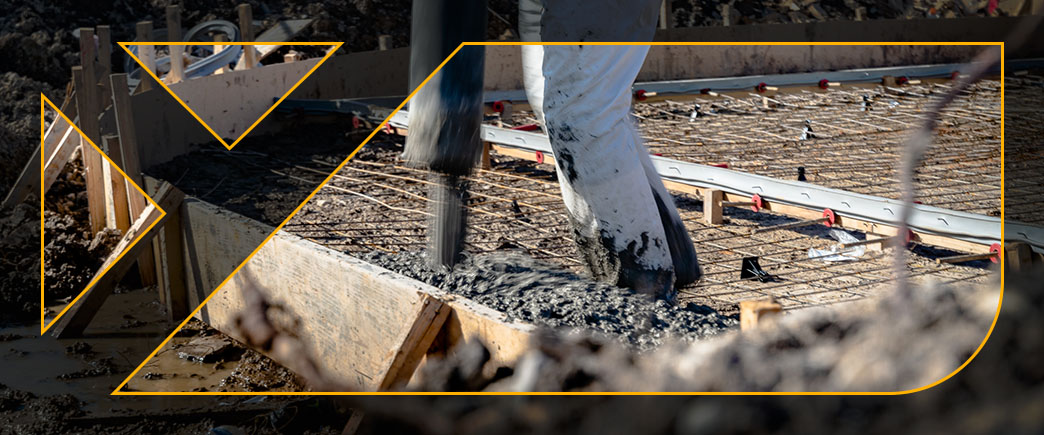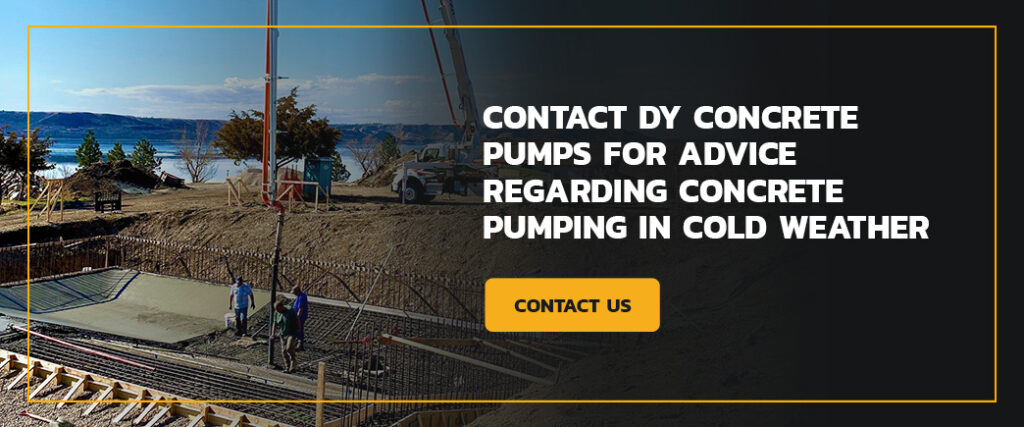How to Pour Concrete in Cold Weather
Posted On: 04/17/2023 | Posted by: DY Concrete Pumps

Many construction operations must work year-round to keep up with project demands and avoid costly shutdowns, requiring them to pour concrete even during winter. Winter temperatures drop in regions such as the northern United States and Canada, meaning companies routinely pour concrete in the cold.
Concrete Pouring in the Winter and Cold Weather
You can pour concrete in the winter if you follow steps and precautions to prevent the material from freezing. A chemical reaction solidifies liquid concrete, but the reaction slows in cold temperatures. Fresh concrete is vulnerable to pressure and can expand and crack in the cold, so it’s essential to protect it until it hardens.
According to the American Concrete Institute, cold weather consists of average daily air temperatures that drop lower than 40 degrees Fahrenheit and remain below 50 degrees Fahrenheit for more than 12 hours during any 24-hour period.
How Cold Can You Pour Concrete?
You can pour concrete in any temperature if the ground remains at or above 40 degrees Fahrenheit. Before pouring concrete, it’s crucial to consider how low the temperature may drop during the protection period, which is the time when you need to shield the poured concrete from exposure to cold temperatures while it cures.
Preventing exposure to cold temperatures allows the concrete to become strong and durable. The lower the temperature drops, the more protection you need to apply.

How to Pour Concrete in Winter
Successfully completing winter construction jobs may require you to pour concrete in various temperatures. Consider the following tips for pouring concrete in cold weather.
Thaw the Ground
Avoid pouring concrete onto frozen ground, ice or snow. The ground can be at freezing temperatures even when the air is above freezing, so you should always check the ground temperature before pouring concrete. If the ground is below 40 degrees Fahrenheit, sufficiently thaw it with one or more of the following methods.
- Heated blankets: Heated blankets operate on electricity to direct thermal energy into the ground and insulate the surface, increasing the temperature until it can support proper concrete curing.
- Ground heaters: A hydronic ground heater uses a hose, pump, boiler, blower fan and a propylene glycol mixture to warm the ground. You can place the hose on the ground’s surface in evenly spaced loops. The heated propylene glycol flows through the hose to warm the ground while the fan disperses hot air to aid the process.
- Black plastic: You can drape black plastic over the ground to insulate it.
Pick the Right Material and Store It Properly
Specialized cold-weather concrete cures faster than other types. When choosing cold-weather concrete, select a material that includes the proper amount of air-entrained voids that will minimize the impact of frequent freezing and thawing. The concrete should also feature minimal slump and a low water-to-cement ratio, which will prevent bleeding and significantly reduce setting time. Once you choose the correct material, store it in a warm, dry place.
Pour at the Right Time
Pour and place the concrete as soon as possible after its arrival at the job site. Remember — fresh concrete that freezes within the first 24 hours can lose up to half its strength. Using a concrete pump allows you to pour concrete efficiently so you can insulate it faster.
Hydrate the Concrete Properly
Hydration is a chemical reaction that occurs when water’s oxygen and hydrogen molecules bond with the cement’s compounds to hydrate it. During this time, the concrete is in a plastic state to facilitate transporting and placing. Low temperatures can hinder hydration, so it’s essential to keep cement warm.
Even if you keep the dry product in a warm area, you may also need to elevate the temperature during the hydration period. You can accomplish this by adding extra cement or water to the mixture, heating the concrete mix’s components or using a chemical accelerator. It’s also helpful to insulate the concrete immediately after pouring it to trap heat during hydration.
Protect the Poured Concrete
Protect concrete while it cures by maintaining the correct temperature for at least five days. That waiting period allows it to fully cure before you expose it to freezing temperatures. The temperature should remain at or above 40 degrees Fahrenheit for at least five days after removing a heated enclosure or insulated blankets. If you choose to protect concrete with heated enclosures, ensure they are windproof and weatherproof.
Determine the appropriate protection requirements for the concrete and take steps to prevent freezing immediately after pouring. It’s also vital to consider a concrete’s strength requirements. Understanding its strength requirements enables you to provide adequate protection for the poured concrete at specific temperatures.
Track Temperature Changes
Since maintaining the right temperature is a large part of protecting concrete while it cures, tracking the temperature is crucial during this process. Use a chart to track changes in the air temperature and the concrete’s internal temperature.
Contact DY Concrete Pumps for Advice Regarding Concrete Pumping in Cold Weather
Thawing the ground properly, pouring concrete quickly and insulating it protects it from freezing in cold temperatures. Using a concrete pump is an excellent way to pour concrete efficiently, giving you adequate time to insulate it and maintain a protective temperature.
DY Concrete Pumps, Inc. provides concrete pumping equipment to the construction industry, and we have been a trusted supplier for years. With offices in Calgary, AB, Canada, we understand what it takes to deliver superior results when pumping and pouring concrete in freezing weather. Contact us to learn more about our concrete pumping equipment.


 1-844-397-8677
1-844-397-8677



